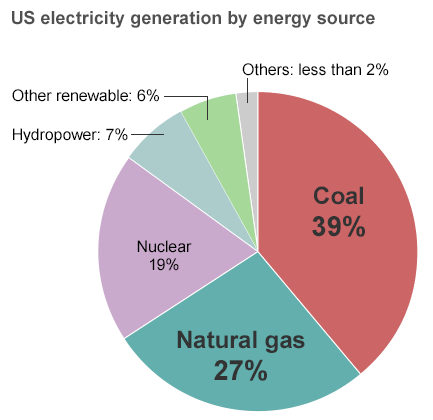Obama unveils historical attempt to curb coal power plants emissions
US President Barack Obama unveiled Monday his awaited new environmental policy aimed to curb the country’s greenhouse gas emissions by 30% by 2030, with all the states having until 2017 to comply with the new rules.
The 645-page document, developed by the Environmental Protection Agency (EPA), is a centrepiece of the Obama administration’s climate change strategy. It is also the first time in the history of the US that a President imposes limits on power plant emissions, which could transform a sector that currently relies on coal for nearly 38% of electricity.
The rule, scheduled to be completed a year from now, gives much flexibility to the states, as they can decide how to meet the reductions. This includes expanding renewable-energy generation, working with other states to create regional plans and investing in or creating new energy-efficiency programs.
Each state will have a different reduction standard, and the national average will be 25% by 2020 and 30% by 2030, according to the EPA. The agency is asking states to submit implementation plans by June 2016, but the EPA is also giving states the option to extend that by one year.
Critics of the agency are already questioning the rule’s costs and benefits. The US Chamber of Commerce released a report last week predicting it would cost the economy $51 billion and 224,200 jobs each year. The report prompted a top EPA spokesman to respond with a blog post the same day.
“The U.S. Chamber of Commerce released a report that makes unfounded assumptions about the EPA’s upcoming proposal for common sense standards to cut the harmful carbon pollution from power plants,” wrote Tom Reynolds, EPA associate administrator for external affairs and environmental education.
According to the agency, the new rules will shrink electricity bills by an estimated 8% by increasing energy efficiency and reducing demand on the electricity system.
But beyond figures, EPA’s head Gina McCarthy said both the government and the industry have “a moral obligation” to act on climate.
“When we do, we’ll turn climate risk into business opportunity, we’ll spur innovation and investment, and we’ll build a world-leading clean energy economy,” she said in her speech.
“The science is clear. The risks are clear. And the high costs of climate inaction keep piling up,” she added.
Winners and losers
Experts believe West Virginia will be the hardest hit by the new measures. The state, one of the US’s three poorest by household income, sits at the heart of coal country. Official figures also show the state gets 95% of its power from the fossil fuel.
The National Association of Manufacturers argues the plan will severely hurt American competitiveness. And the United Mine Workers of America (UMWA) argues the regulations will financially cripple coal’s economy, kicking miners to the curb.
The EPA backfires saying the regulations could yield over $90 billion dollars in climate and health benefits.
From a public health perspective, smog and pollution drops that would also be achieved through the plan, would translate into a $7 health benefit for every dollar invested in the plan, McCarthy says.
And, according to the agency’s estimates, reducing exposure to particle pollution and ozone could prevent up to 150,000 asthma attacks in children and as many as 3,300 heart attacks by 2030, among other impacts.
The rules, when finalized, are expected to have an impact that extends far beyond the United States.
National Post Editor Kelly McParland, for one, believes they will benefit Canada:
It may be good news for Canada, in a backhanded kind of way. With no plan of its own, Washington has spent a good deal of time complaining that Canada lacks an adequate strategy to address the emissions issue. Coal is by far the dirtiest way to produce electricity, and Canada uses far less of it than the U.S. – and is farther ahead in reducing its usage – yet Washington keeps citing Canadian emissions policies as a significant reason Mr. Obama hasn’t been able to bring himself to make a decision on the Keystone XL oil pipeline.
Coal-fired power plants have already been closing across the country. Department of Energy data indicates the number has fallen from 633 in 2002 to 557 in 2012 and it expects 60 gigawatts of coal-fired power — one-fifth of total US coal capacity in 2012 — will retire by 2020.
{{ commodity.name }}
{{ post.title }}
{{ post.date }}






Comments